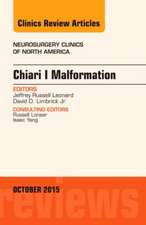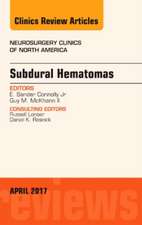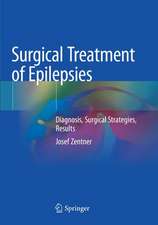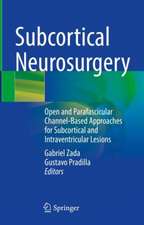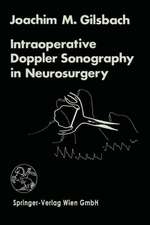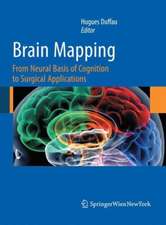Endoscopic Third Ventriculostomy: Classic Concepts and a State-of-the-Art Guide
Autor Roberto Alexandre Dezenaen Limba Engleză Hardback – 25 oct 2019
The book is structured in 2 parts and into 7 chapters. Part I – Classic Concepts – comprises the first 2 chapters, covering general aspects of neuroendoscopy such as historical notes, endoscopic anatomy and ventricular system physiology. Part II – State-of-the-Art – comprises chapters 3 to 7. From chapters 3 to 6 the book will discuss general principles of endoscopic ventricular technique and the applications of endoscopic third ventriculostomy in different age groups, and its association to choroid plexus coagulation. Chapter 7 deals with alternative ways of communicating the ventricular system with the cisterns of the subarachnoid space. All chapters are richly illustrated with high resolution images; there are links to online access to demonstrative surgical videos.
Designed for neurosurgeons at every level, the book will be unique in the market, as there is no similar book in the current scientific literature that specifically discusses endoscopic third ventriculostomy in its broadest sense.
| Toate formatele și edițiile | Preț | Express |
|---|---|---|
| Paperback (1) | 324.27 lei 38-45 zile | |
| Springer International Publishing – 25 oct 2020 | 324.27 lei 38-45 zile | |
| Hardback (1) | 332.01 lei 38-45 zile | |
| Springer International Publishing – 25 oct 2019 | 332.01 lei 38-45 zile |
Preț: 332.01 lei
Preț vechi: 349.48 lei
-5% Nou
Puncte Express: 498
Preț estimativ în valută:
63.53€ • 67.94$ • 52.97£
63.53€ • 67.94$ • 52.97£
Carte tipărită la comandă
Livrare economică 14-21 aprilie
Preluare comenzi: 021 569.72.76
Specificații
ISBN-13: 9783030286569
ISBN-10: 3030286568
Pagini: 111
Ilustrații: XII, 111 p. 76 illus., 65 illus. in color. With online files/update.
Dimensiuni: 155 x 235 mm
Ediția:1st ed. 2020
Editura: Springer International Publishing
Colecția Springer
Locul publicării:Cham, Switzerland
ISBN-10: 3030286568
Pagini: 111
Ilustrații: XII, 111 p. 76 illus., 65 illus. in color. With online files/update.
Dimensiuni: 155 x 235 mm
Ediția:1st ed. 2020
Editura: Springer International Publishing
Colecția Springer
Locul publicării:Cham, Switzerland
Cuprins
Part I Classic ConceptsChapter 1. Historical Aspects of Hydrocephalus and its Treatments
Chapter 2. Anatomy and Physiology of the Ventricular System
Part II State-of-the-Art
Chapter 3: Endoscopic Ventricular Anatomy
Chapter 4: Basic Principles of Endoscopic Neurosurgery
Chapter 5: General Principles of Endoscopic Third Ventriculostomy (ETV)
Chapter 6: Surgical Technique of Endoscopic Third Ventriculostomy (ETV)
Chapter 7: Alternative Technique: Endoscopic Transseptumpellucidumrostrostomy (ETSPR)
Chapter 2. Anatomy and Physiology of the Ventricular System
Part II State-of-the-Art
Chapter 3: Endoscopic Ventricular Anatomy
Chapter 4: Basic Principles of Endoscopic Neurosurgery
Chapter 5: General Principles of Endoscopic Third Ventriculostomy (ETV)
Chapter 6: Surgical Technique of Endoscopic Third Ventriculostomy (ETV)
Chapter 7: Alternative Technique: Endoscopic Transseptumpellucidumrostrostomy (ETSPR)
Notă biografică
Roberto Alexandre Dezena, M.D., Ph.D.
Associate Professor and Chief
Neurosurgery Residency Program Director
Division of Neurosurgery
Neurological System Unit
Clinics Hospital
Federal University of Triângulo Mineiro
Uberaba, Minas Gerais, Brazil
MD from Federal University of Triângulo Mineiro, Uberaba, Brazil (2003), medical residency in Neurosurgery at Santa Casa de Misericórdia de Ribeirão Preto, Brazil (2009), Ph.D. in Neurosurgery at Ribeirão Preto Medical School of University of São Paulo, Brazil (2011), and Postdoctoral Fellowship at Federal University of Triângulo Mineiro, Uberaba, Brazil (2014). Fellow of Eberhard-Karls Universität Tübingen, Germany, Hiroshima University, Japan, and Saint Louis University, USA. In Brazil, he is Full Member of Brazilian Society of Neurosurgery (SBN) and Brazilian Academy of Neurosurgery (ABNc), besides vice president of Minas Gerais Neurosurgery Society and member of deliberative counsil of Brazilian Academy of Neurosurgery. Internationally, he is Fellow of World Federation of Neurosurgical Societes (WFNS), Active Member of International Federation of Neuroendoscopy (IFNE), Active Member of International Society for Pediatric Neurosurgery (ISPN), Active Member of Walter E. Dandy Neurosurgical Society (WEDNS), and Full Member of both Latin American Federation of Neurosurgery Societes (FLANC) and Latin American Group of Studies in Neuroendoscopy (GLEN). Currently is Associate Professor and Chief of Division of Neurosurgery, Clinics Hospital, Federal University of Triângulo Mineiro, and Professor of Postgraduate Program in Health Sciences and Postgraduate Program in Applied Biosciences, both at Federal University of Triângulo Mineiro, Uberaba, Brazil. Director of the Reference Center for Continuing Education of Latin American Federation of Neurosurgery Societes (FLANC), at the same university. Neurosurgical activities in Microneurosurgery (vascular and neuro-oncology), Endoscopic Neurosurgery, Pediatric Neurosurgery, Spine Surgery and Neurotrauma, all in clinical and surgical care, teaching and research activities. Furthermore he is Editorial Board Member of Brazilian Journal of Neurosurgery (ABNc), Journal of Neurology and Stroke (Medcrave), EC Neurology (EC), International Journal of Anesthesiology Research (Phaps), International Journal of Pediatrics and Child Health (Savvy), Medical Research Archives (KEI), Pediatric Neurology (JSM) and Journal Of Clinical Neurology, Neurosurgery and Spine (Scientific Literature), besides reviewer of online scientific journals, highlighting World Neurosurgery (World Federation of Neurosurgical Societes - WFNS), Neurological Research (Maney) and Journal of Neurosurgical Sciences (Minerva). Acts also in private clinic and hospitals.
Associate Professor and Chief
Neurosurgery Residency Program Director
Division of Neurosurgery
Neurological System Unit
Clinics Hospital
Federal University of Triângulo Mineiro
Uberaba, Minas Gerais, Brazil
MD from Federal University of Triângulo Mineiro, Uberaba, Brazil (2003), medical residency in Neurosurgery at Santa Casa de Misericórdia de Ribeirão Preto, Brazil (2009), Ph.D. in Neurosurgery at Ribeirão Preto Medical School of University of São Paulo, Brazil (2011), and Postdoctoral Fellowship at Federal University of Triângulo Mineiro, Uberaba, Brazil (2014). Fellow of Eberhard-Karls Universität Tübingen, Germany, Hiroshima University, Japan, and Saint Louis University, USA. In Brazil, he is Full Member of Brazilian Society of Neurosurgery (SBN) and Brazilian Academy of Neurosurgery (ABNc), besides vice president of Minas Gerais Neurosurgery Society and member of deliberative counsil of Brazilian Academy of Neurosurgery. Internationally, he is Fellow of World Federation of Neurosurgical Societes (WFNS), Active Member of International Federation of Neuroendoscopy (IFNE), Active Member of International Society for Pediatric Neurosurgery (ISPN), Active Member of Walter E. Dandy Neurosurgical Society (WEDNS), and Full Member of both Latin American Federation of Neurosurgery Societes (FLANC) and Latin American Group of Studies in Neuroendoscopy (GLEN). Currently is Associate Professor and Chief of Division of Neurosurgery, Clinics Hospital, Federal University of Triângulo Mineiro, and Professor of Postgraduate Program in Health Sciences and Postgraduate Program in Applied Biosciences, both at Federal University of Triângulo Mineiro, Uberaba, Brazil. Director of the Reference Center for Continuing Education of Latin American Federation of Neurosurgery Societes (FLANC), at the same university. Neurosurgical activities in Microneurosurgery (vascular and neuro-oncology), Endoscopic Neurosurgery, Pediatric Neurosurgery, Spine Surgery and Neurotrauma, all in clinical and surgical care, teaching and research activities. Furthermore he is Editorial Board Member of Brazilian Journal of Neurosurgery (ABNc), Journal of Neurology and Stroke (Medcrave), EC Neurology (EC), International Journal of Anesthesiology Research (Phaps), International Journal of Pediatrics and Child Health (Savvy), Medical Research Archives (KEI), Pediatric Neurology (JSM) and Journal Of Clinical Neurology, Neurosurgery and Spine (Scientific Literature), besides reviewer of online scientific journals, highlighting World Neurosurgery (World Federation of Neurosurgical Societes - WFNS), Neurological Research (Maney) and Journal of Neurosurgical Sciences (Minerva). Acts also in private clinic and hospitals.
Textul de pe ultima copertă
Endoscopic third ventriculostomy is the most widely performed neuroendoscopic procedure around the world. Several scientific papers appear in the scientific literature every month, with an increasing number, given the great interest neuroendoscopy has aroused as well as controversies about certain aspects of endoscopic third ventriculostomy. With this reasoning, the goal of this book is to be a reference in the revision of classic concepts and scientifically proven aspects about the indications and techniques of endoscopic third ventriculostomy, as well as new neuroendoscopic tendencies.
The book is structured in 2 parts and into 7 chapters. Part I – Classic Concepts – comprises the first 2 chapters, covering general aspects of neuroendoscopy such as historical notes, endoscopic anatomy and ventricular system physiology. Part II – State-of-the-Art – comprises chapters 3 to 7. From chapters 3 to 6 the book will discuss general principles of endoscopic ventricular technique and the applications of endoscopic third ventriculostomy in different age groups, and its association to choroid plexus coagulation. Chapter 7 deals with alternative ways of communicating the ventricular system with the cisterns of the subarachnoid space. All chapters are richly illustrated with high resolution images; there are links to online access to demonstrative surgical videos.
Designed for neurosurgeons at every level, the book will be unique in the market, as there is no similar book in the current scientific literature that specifically discusses endoscopic third ventriculostomy in its broadest sense.
Designed for neurosurgeons at every level, the book will be unique in the market, as there is no similar book in the current scientific literature that specifically discusses endoscopic third ventriculostomy in its broadest sense.
Caracteristici
Unique title in the field Comprehensive review A large number of high resolution images



